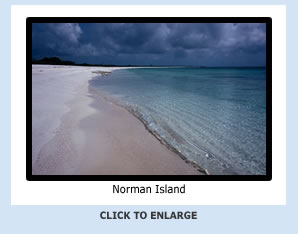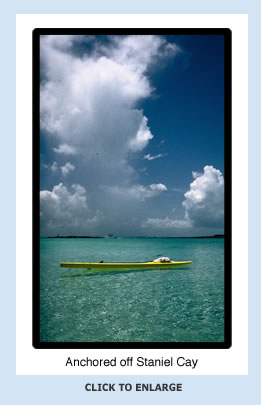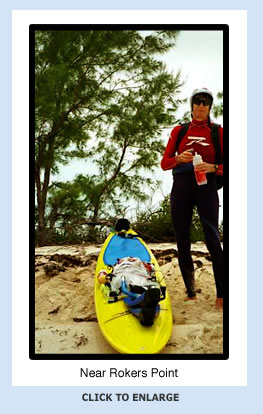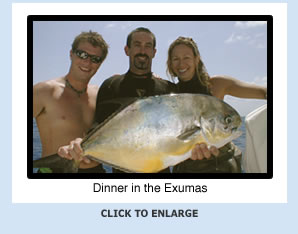|
 |
 If
beauty had a backbone, the Exuma Cays in the Bahamas, would be it.
Linked like vertebrae, the pristine limestone Exuma islands stretch
one hundred fifty miles from Great Exuma almost to the capital of
the Bahamas, Nassau. The Exumas are composed of hundreds of islands
and support two obvious ecosystems: The Exuma Banks, off the islands’ west
coast, are an enormous, calm, chartreuse shallows loved by minnows,
stingrays, barracudas, and colorful reef fish. Exuma Sound, to the
east, is a deep ocean trench full of high winds, forceful current,
steep waves, and big predators.
If
beauty had a backbone, the Exuma Cays in the Bahamas, would be it.
Linked like vertebrae, the pristine limestone Exuma islands stretch
one hundred fifty miles from Great Exuma almost to the capital of
the Bahamas, Nassau. The Exumas are composed of hundreds of islands
and support two obvious ecosystems: The Exuma Banks, off the islands’ west
coast, are an enormous, calm, chartreuse shallows loved by minnows,
stingrays, barracudas, and colorful reef fish. Exuma Sound, to the
east, is a deep ocean trench full of high winds, forceful current,
steep waves, and big predators.
To reach the Exumas, go to Nassau. From here, hop a small plane
to George Town on Great Exuma. Ship your board from Miami to Nassau
with Miami Shipping Company. From Nassau, bring your board with you
on a mail boat, like the Grand Master, to George Town.
Bring documents to George Town stating that your board has passed
Customs in Nassau. If not, your board will be impounded on Exuma
until the documents can be faxed from Nassau. Given the frequent
failure of electricity on Exuma, the process could take days. As
happened to me, your board will be trucked to a lot in central Exuma.
There it will incinerate in the hundred-degree heat, delaminate,
and be much harder to paddle.
 In George Town, stay at the Peace and Plenty
Hotel. Fresh fish, fruit and vegetables scarce in the Exumas, the “plenty” refers
to Kalik beer and deep-fried cracked conch. From the Peace and Plenty,
it’s a short hike to the Tourist Board. They can help you plot
overnight stops along your route, and will tell you who to call on
you VHF radio or cell phone when you are being circled by sharks.
In George Town, stay at the Peace and Plenty
Hotel. Fresh fish, fruit and vegetables scarce in the Exumas, the “plenty” refers
to Kalik beer and deep-fried cracked conch. From the Peace and Plenty,
it’s a short hike to the Tourist Board. They can help you plot
overnight stops along your route, and will tell you who to call on
you VHF radio or cell phone when you are being circled by sharks.
Paddle north up Great Exuma’s east coast. You will be sheltered
from the infamous, Bahamas east wind by Stocking Island. It’s
twenty miles from George Town to Rolleville where you can replenish
calories and sleep. Rokers Point, about ten miles north of Georgetown,
is a crucible. Here, you are at the mercy of the open Atlantic. Breaking
waves can wreck you on the coral. If you reach Rolleville, you won’t
find lodging, but a member of the Rolle family, who are a well-established,
well-heeled presence in the Exumas, will let you pay them for food
and shelter.
From Rolleville, proceed to Barreterre, a
square island a mile from the north tip of Exuma. Barreterre strands
at low tide in mud and sand-shallows. You will be well received
on Barreterre and perhaps directed to the Reverend A.A Mackenzie
(if he hasn’t died).
He takes in travelers and will let you overnight for a steep fee.
Perhaps he will cut you a Barrie Stick, a two-foot length of pole
carried by locals in their boats to ward off barracudas. It’s
bad luck to lose your Barrie Stick.
After your night on the Reverend’s
bedsprings, cross the narrow, powder-blue, shallow channel west
to the Exumas that you will see sailing north, end-to-end, like
stone Spanish galleons. Six miles from Barreterre (if, you consult
the waterproof charts and the handheld GPS that, hopefully, you
brought with you) you will find Lee Stocking Island, Lee Stocking
harbors a school for marine biologists. Young students will celebrate
you for being the peculiar marine creature that you are.
From Lee Stocking, count, like beads in a
rosary of beauty, islands like Bock Cay, Prime Cay, Darby Island
and Ruddercut Cay. You may think things couldn’t get more beautiful. But they do. As you
go north, the islands seem ever more pure and remote; the ocean grows
increasingly clear and more emerald and aquamarine. The sky distills
increasingly into pure sapphire. Don’t get hypnotized. Stay
clear of the cuts between islands. Tidal current in the cuts flows
at eight knots. You can be vacuumed from the placid Exuma Banks into
the open ocean in Exuma Sound. The only way to return to the lee
side of the islands is to wait hours until the tide reverses.
Six or so miles past Lee Stocking is Musha
Cay. When I stayed there, the island was being transformed into
a very exclusive resort, the kind of crash pad that entertains
George W and Halle Berry. In my case, the Tourist Board contacted
a project supervisor. I was allowed to overnight in the employees’ dormitory. This would not be
an option for you, so unless you’re very rich, or Tom Cruise,
continue on a few miles north.
After Cave Cay and Farmer’s Cay, comes a speck called Little
Farmer’s Cay. Here, you will be mobbed by well wishers and
inexpensively loved to death. Locals on Little Farmer’s Cay
can’t wait to stuff you with—guess what! —fried
conch, and they practically dismember you in an attempt to be the
first to offer you free lodging. Enjoy the hospitality!
 Ten-mile-long Great Guana Cay waits for you
just past Little Farmers. By now you are well acquainted with Exumian
hazards. The barracudas that patrol next to your board like silver-gray
submarines, and the sharks—bulls, hammerheads, and tigers—don’t bother
you. But, let me warn you, thunderstorms are highly aggressive in
the Exumas. Boaters are struck by lightning. Take cover in an electrical
storm. The forefront of a storm packs the highest voltage. Hide in
a shoreline cave, of which there are many on Guana, OUT of the water.
Do the lightning crouch: Squat in low scrub on your heels with your
elbows low and hands cupped to your ears Be careful, though, that
the bushes you hide in are not poisonwood. This attractive bush,
with its silver-dollar-size leaves, has sap that burns like acid.
When you use nature’s latrine, make sure not to apply poisonwood
leaves to your bum.
Ten-mile-long Great Guana Cay waits for you
just past Little Farmers. By now you are well acquainted with Exumian
hazards. The barracudas that patrol next to your board like silver-gray
submarines, and the sharks—bulls, hammerheads, and tigers—don’t bother
you. But, let me warn you, thunderstorms are highly aggressive in
the Exumas. Boaters are struck by lightning. Take cover in an electrical
storm. The forefront of a storm packs the highest voltage. Hide in
a shoreline cave, of which there are many on Guana, OUT of the water.
Do the lightning crouch: Squat in low scrub on your heels with your
elbows low and hands cupped to your ears Be careful, though, that
the bushes you hide in are not poisonwood. This attractive bush,
with its silver-dollar-size leaves, has sap that burns like acid.
When you use nature’s latrine, make sure not to apply poisonwood
leaves to your bum.
At the north end of Guana Cay, is the town of Black Point, a good
overnight stop. Black Point is highly populated. Its families produce
legions of kids who become fishermen and subsistence livers. People
are friendly, but, while in Black Point, you may learn that the difference
between being solicited and robbed is negligible. Watch your things.
Staniel Cay, the tourist trap of the Exumas, is your next stop.
Accessible by small plane and a stopover for ferries enroute between
Exuma and Nassau, tourists who want to taste local life, flock to
Staniel Cay. They are disappointed, as will you be. Staniel Cay has
attitude. When patronizing local businesses, you may find yourself
being snapped at, overcharged and only approved of if you show a
tendency to immediately leave the island.
After reeling in a few more islands, like
Fowl Cay Sampson Cay, and Overyonder Cay, you will relax on Compass
Cay. This unspoiled islet has a long trackless beach, a small marina,
and clean rooms for rent. A flock of odd sea gypsies linger around
Compass Cay in decrepit watercraft for months, even years, seemingly
for the sole purpose of entertaining you. Stock up on food on Compass.
It is a long way to your next stopover—twenty miles—to
Warderick Wells.
Warderick Wells is a national park. Park
Wardens, armed guards who oust fish and lobster poachers caught
within Park boundaries at gunpoint, live in houses visible on a
hilltop and known as “Park Headquarters”.
Whatever shape you’re in when you land on Warderick Wells,
you will be given a mop, broom, pail, scrub brush, or wood-cutting
shears. Unannounced visitors are commandeered as volunteer workers
in the park. In exchange for a bunk, a few boiled eggs, rice and
an occasional fish, you will soon be clearing brush, painting arrows
on rocks so tourists won’t get lost. You may enjoy this so
much you forget to leave.
Between Warderick Wells and Cistern Cay,
is the biggest open channel in the Exumas, the Wide Opening. It
is only eight miles wide but, as the site of gruesome “big fish stories”, full of shallow
coral and open to Atlantic weather systems, it commands respect.
If, like me, you earned the love of the Warderick Wells’ Park
Warden, you may be escorted across the Wide Opening by the spiffy
Park Warden powerboat. Cistern Cay is within park boundaries, so
the warden may bring his poacher-bouncer, a muscular six-foot- Bahamian
who wears strings of machine gun bullets across his bare chest. In
such company, you will feel protected and threatened as you paddle
across the Wide Opening.
At Cistern Cay, you will lose your Park Warden
escort and his bodyguard. They were building a resort on Cistern
Cay when I passed by, so I went on north to Hawksbill Cay. Hawksbill
is unremarkable, except that it supports a colony of rats. If you
picnic on the island, you will be hungrily watched from the poisonwood
trees. Don’t fall
asleep.
North from Hawksbill is Shroud Cay, maybe the most special of Exuma
islands. Shroud is divided into smaller islands by a network of emerald-clear,
deep channels. Paddle up one of the channels. Enjoy the solitude
and silence and silver ripples that travel beneath you along the
pure white sand whenever you take an arm stroke. The quicksilver
minnows, small barracudas and needle fish you find in the channel
look like they are having so much fun you may want to join them.
 Norman Cay, your overnight stop past Warderick
Walls, was a rendezvous for drug runners. A wrecked plane used
by the drug trade remains in the lagoon that takes up much of Norman’s
interior. The drug-running aviators are gone, but many of Norman’s
few residents still fly by the seat of their pants. Dale, the manager
McDuffs, a resort on Norman Cay, flies his small plane in and out
of Norman often. If you look handy and strong, Dale may have you
washing and polishing his hotel in exchange for a bed. Dale’s
dog loves shoes. If you leave yours unattended, he will steal one.
I say “one” because
the dog is not into pairs. He will take one shoe and quickly move
on to cause more divorce among other happily married shoes. Norman Cay, your overnight stop past Warderick
Walls, was a rendezvous for drug runners. A wrecked plane used
by the drug trade remains in the lagoon that takes up much of Norman’s
interior. The drug-running aviators are gone, but many of Norman’s
few residents still fly by the seat of their pants. Dale, the manager
McDuffs, a resort on Norman Cay, flies his small plane in and out
of Norman often. If you look handy and strong, Dale may have you
washing and polishing his hotel in exchange for a bed. Dale’s
dog loves shoes. If you leave yours unattended, he will steal one.
I say “one” because
the dog is not into pairs. He will take one shoe and quickly move
on to cause more divorce among other happily married shoes.
On leaving Norman Cay, your Exumas trip is
almost over. Your next stop is Highburn Cay. Beyond, are Allens
and Roberts Cays, but Highburn is really the Exumas last gasp.
When your reach Highburn, you sense the bustle of the world beyond.
Mega yachts nose in to the well-equipped dock. These sea hogs seldom
travel down the Exumas. They float near Highburn Cay, drink, are
convinced they’ve explored the Exumas,
and then go back to Florida.
If you are a purist like me, you’ll want to paddle the thirty-six
mile channel between Highburn Cay and Nassau. Wait for an east wind—not
hard in the Bahamas. Perhaps, since the seas kick up nastily in the
shallow water between Highburn Cay and Nassau, you’ll want
an escort vessel to follow you. Natch, as a pure paddler, you never
touch your escort vessel. But don’t be too much of a purist!
The Bahamian vessel you recruit may break down and have to anchor
mid-channel. In this case, you must come aboard, and drink and joke
with the captain until he fixes the motor. Who knows, you may have
to take your captain to Nassau on your paddleboard.
Remember, keep your Barrie Stick with your until you leave the Bahamas!
**My description of the Exumas is purely mine. Others who tour the
Exumas will meet different events and people. However, I feel sure
that any visitor to the Exumas will use them as a benchmark for pristine
marine beauty. They may be the most beautiful islands in the world.
Preserve them!
To learn about the Exumas in MUCH greater detail, I recommend The
Exuma Guide by Stephen Pavlidis, and The Explorer Chartbook of the
Exumas by Monty and Sara Lewis and Kate Fears.
|
 |
